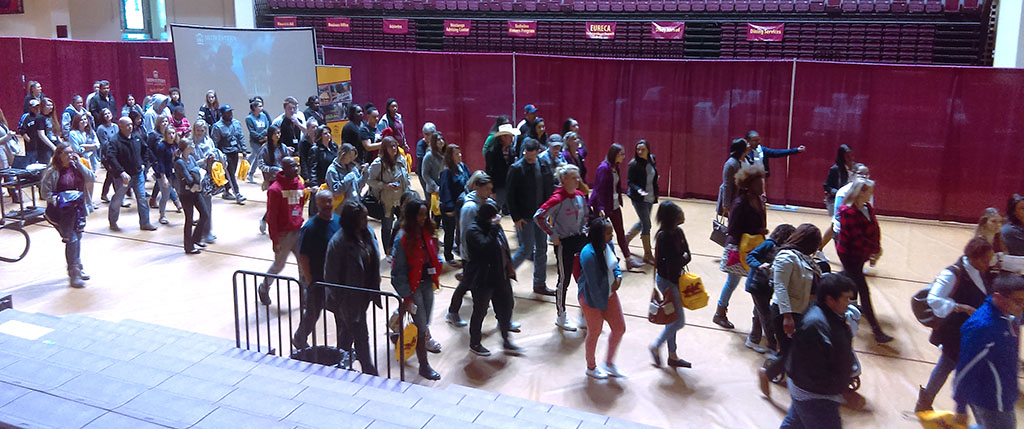
Mustangs Rally welcomed potential students on March 4 with a campus tour, club previews and a hamburger lunch, among other activities. Students and faculty worked together to show potential students and their families what MSU is all about.
“Admissions coordinates this event and other departments help with the processes,” Mario Ramirez, assistant director of student development and orientation, said. “Students, parents and guests get to explore campus beyond the regular campus tour.”
After the general meeting, the students were given tours across campus where they were able to visit the different colleges, departments and majors MSU has to offer.
“We had interest from two students and met extensively with one student and his family,” Brandy Jolliff-Scott, assistant professor and global studies coordinator, said “He seemed very interested in attending MSU.”
Jolliff-Scott also explained the biggest project of the global studies department, Model UN. Many students and their parents found this project the most interesting project in the department.
“We talked a lot about Model UN and the impact it has had on the past and current students,” Jolliff-Scott said. “The upcoming trip to New York City was of great interest, and I think the parents especially were impressed.”
This was an opportunity for club members to present their club to potential students. More than 30 clubs signed up to volunteer.
“The members of the clubs were given the opportunity to talk to prospective Mustangs and their guests,” Ramirez said.
Due to some clubs having giveaways like candy and stickers, some tables were more populated than others. Ramirez explained how this event helped improved the communication skills of current MSU students.
“Some of the groups like the cheer booth and some of the sororities had various students throughout the entire event,” Ramirez said. “I think the student organizations are improving their communication skills and are able to explain how incoming students can join their club.”
Faith Muñoz, English senior and president of the Arts and Literature Society, explained the A and L, which is an organization for students who are interested in art, literature, film, theater and music.
“Students should be interested in the Arts and Literature Society because we are not an exclusive group,” Muñoz said, “I know when I was a freshman the A and L Society was one of the first places I made friends at because we ate together, went on fields trips, or attended events on campus.”
Overall, many members of the clubs and organizations were satisfied by the many different students who attended Mustangs Rally.
“We have talked to two students and their parents,” Tariq Roberts, sophomore social work and historian for the German club, said. “We also talked to a military veteran and an immigrant from Hungary.”
There were also tables for admissions, financial aid and study abroad where students went for further questions. There were more than 100 students who stopped by the study abroad table to learn more information and to see what programs MSU offers.
“I recommended that if they were interested in studying abroad to stop by the Office of International Education sometime during their freshmen year to get more details about our programs,” Michael Mills, international education director, said. “Starting to plan early can help them maximize scholarship opportunities and make sure the courses fit into their degree plan.”
Mustangs Rally shows future students, parents and guests what it looks like to attend MSU. Its also how student organizations and university departments showcase what they bring to the table.
“There are infinite amounts of ways to get involved and learn more about what college life is, and this program gives those attending a peek into the Mustang way,” Ramirez said.
Many students and their parents say that what MSU does best is combine quality teaching with small class sizes that gives students the kind of one-on-one attention which is hard to get at a larger university.
“There are so many things I can do in the classroom, simulations, games, other active learning techniques, that I simply couldn’t do in a university with 200 students per class,” Jolliff-Scott said. “Those are the kind of teaching moments that stick with students and make them engaged in learning and excited about the process.”














